外研高一必修2 Module 2 No Drugs模块复习课件(66张)
文档属性
| 名称 | 外研高一必修2 Module 2 No Drugs模块复习课件(66张) | 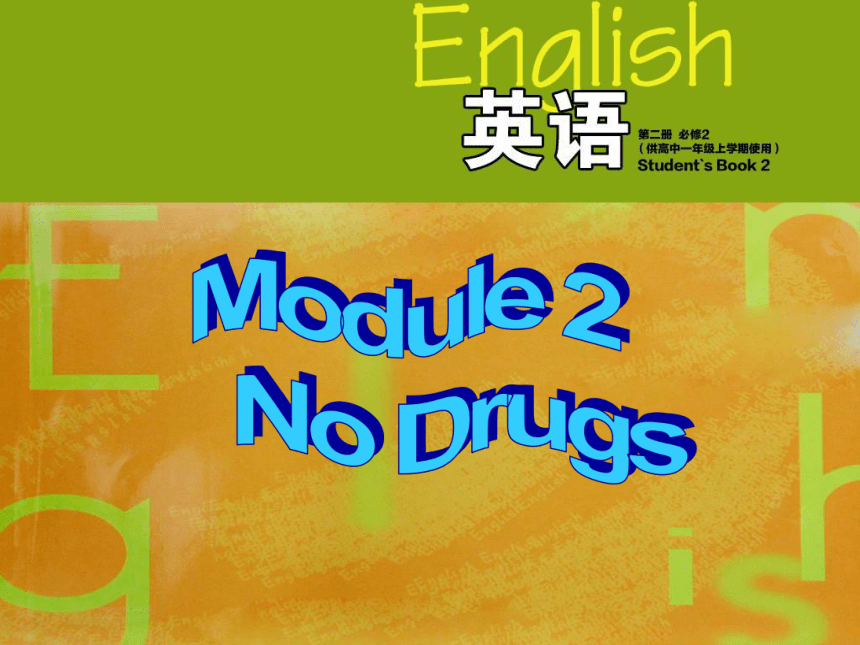 | |
| 格式 | zip | ||
| 文件大小 | 500.7KB | ||
| 资源类型 | 教案 | ||
| 版本资源 | 外研版 | ||
| 科目 | 英语 | ||
| 更新时间 | 2017-01-18 20:02:57 | ||
图片预览

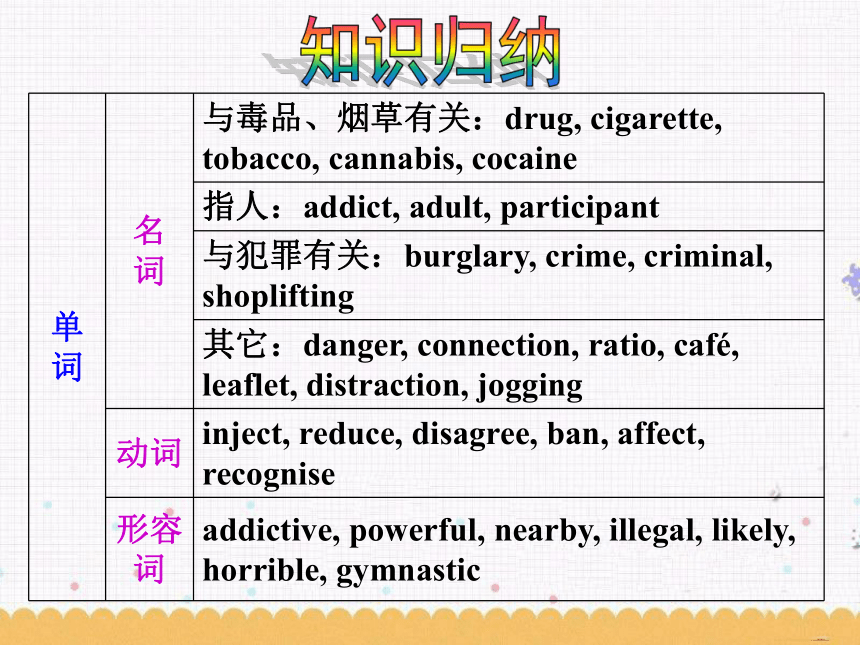
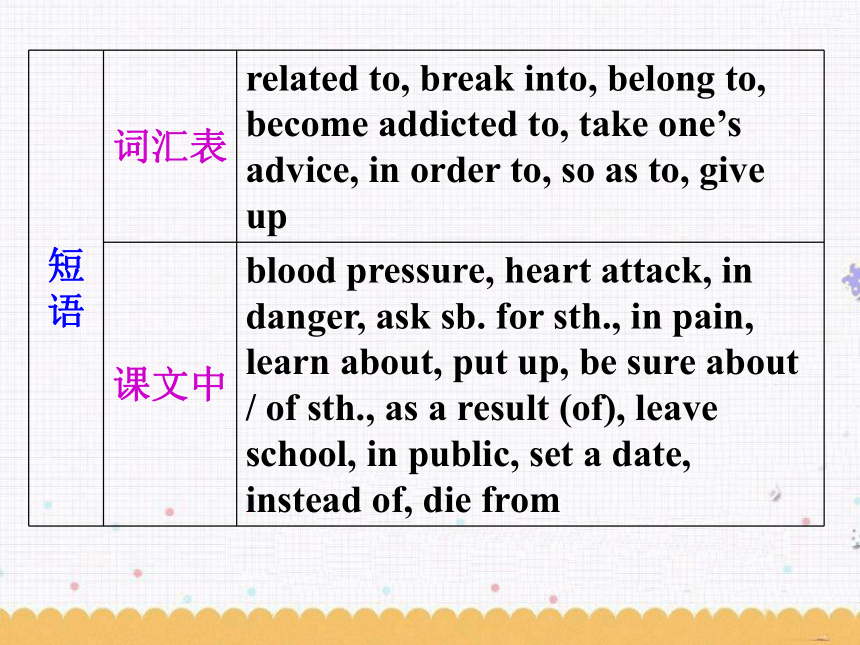
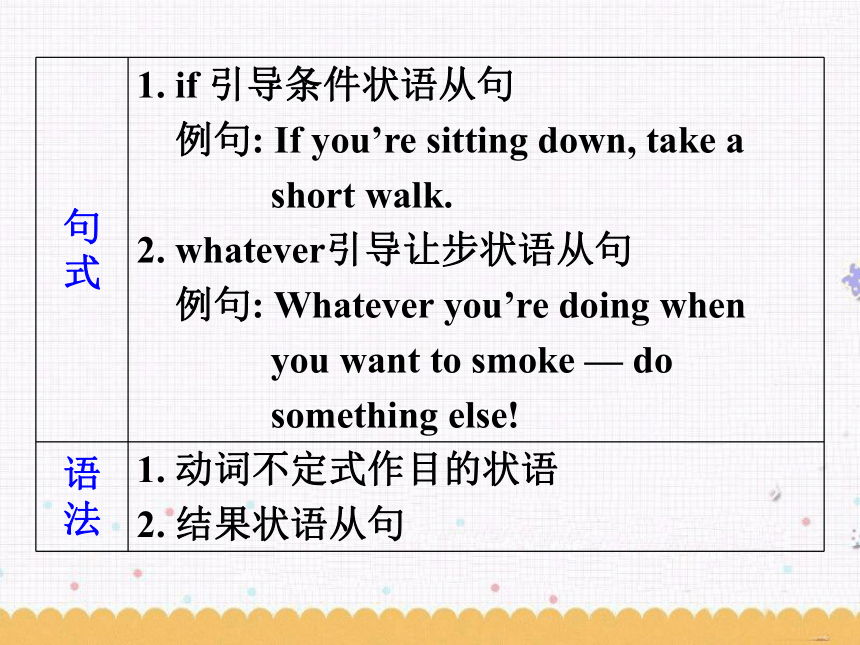

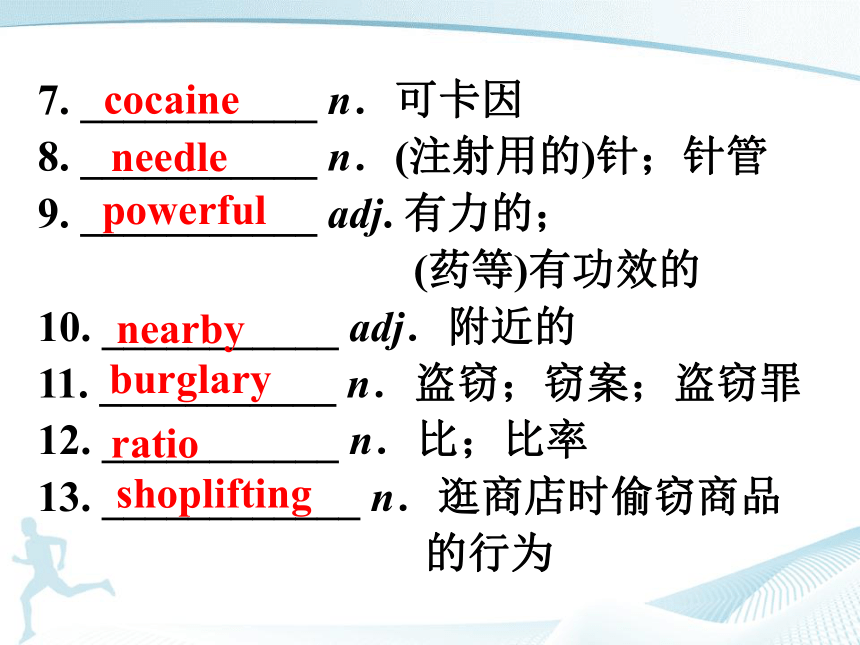
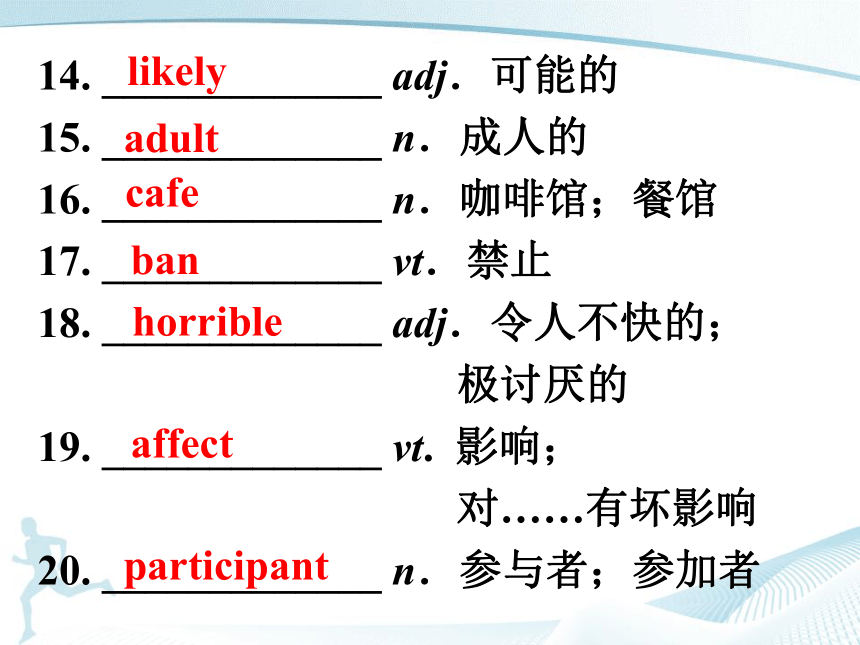
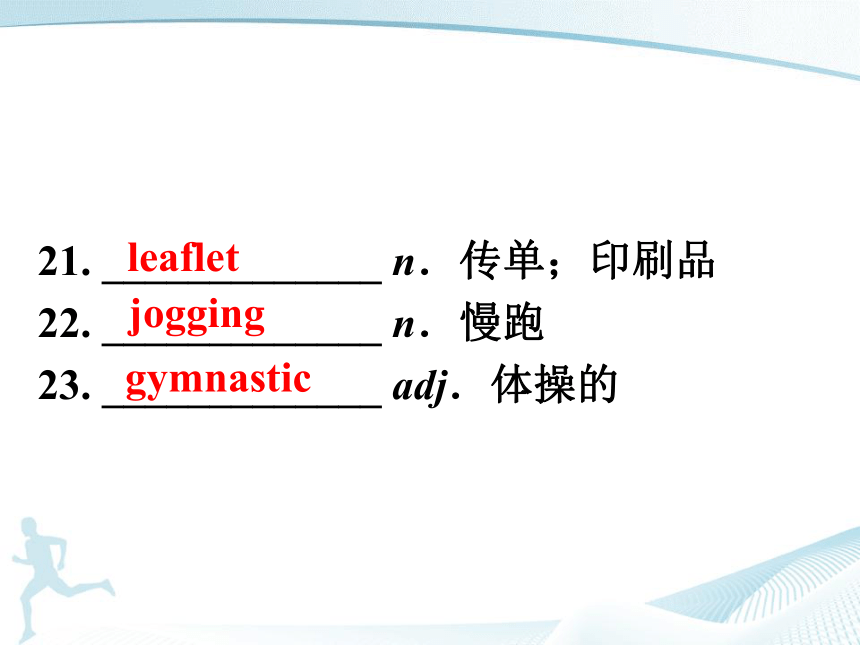

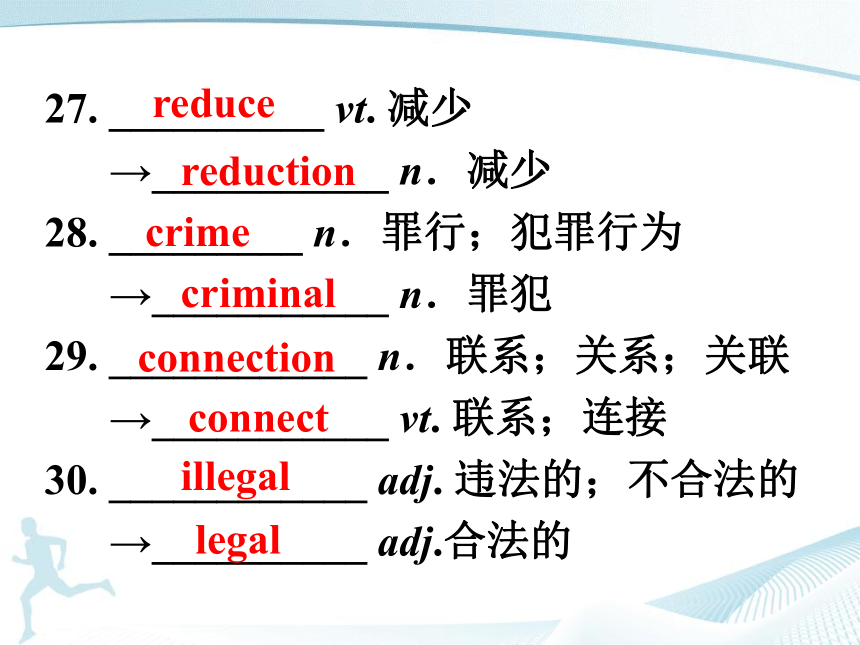
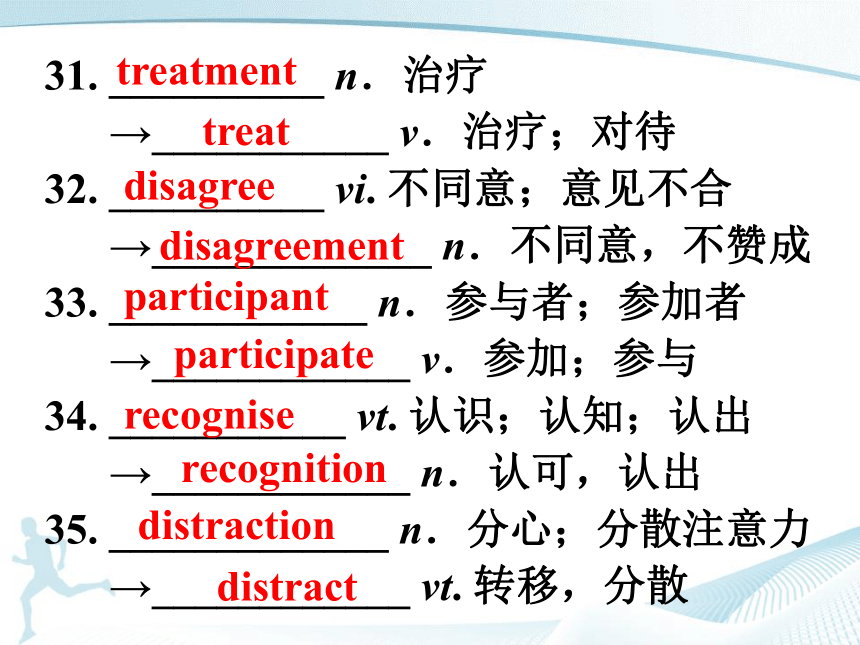
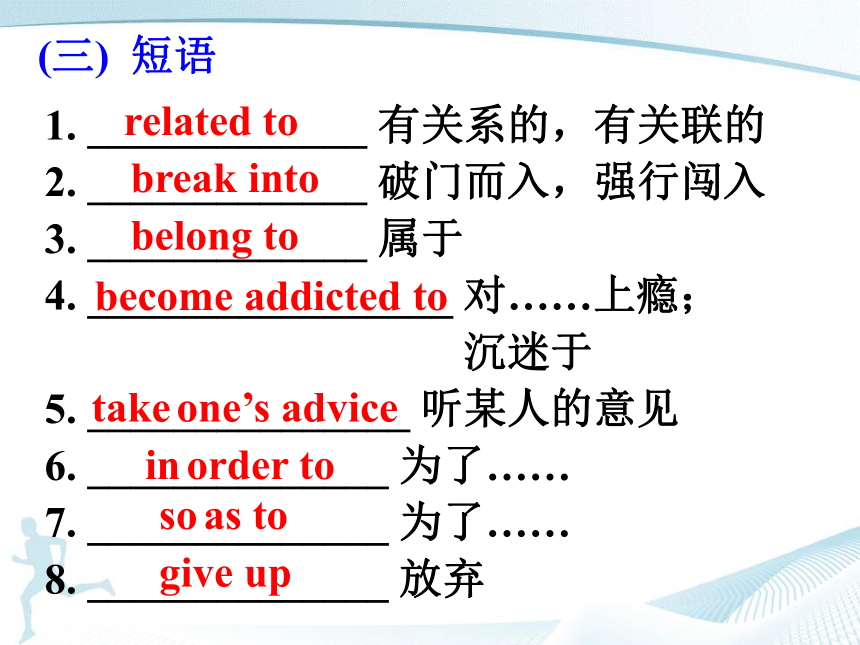
文档简介
课件69张PPT。Module 2
No Drugs 知识归纳知识清单(一)基本单词1. ___________ n.毒品;药品
2. ___________ n.支气管炎
3. ___________ n.癌症
4. ___________ n.香烟
5. ___________ n.烟草;烟丝
6. ___________ n. 大麻drugbronchitiscancercigarettetobaccocannabis7. ___________ n.可卡因
8. ___________ n.(注射用的)针;针管
9. ___________ adj. 有力的;
(药等)有功效的
10. ___________ adj.附近的
11. ___________ n.盗窃;窃案;盗窃罪
12. ___________ n.比;比率
13. ____________ n.逛商店时偷窃商品
的行为cocaineneedlepowerfulnearbyburglaryratioshoplifting14. _____________ adj.可能的
15. _____________ n.成人的
16. _____________ n.咖啡馆;餐馆
17. _____________ vt.禁止
18. _____________ adj.令人不快的;
极讨厌的
19. _____________ vt. 影响;
对……有坏影响
20. _____________ n.参与者;参加者likelyadultcafebanaffectparticipanthorrible21. _____________ n.传单;印刷品
22. _____________ n.慢跑
23. _____________ adj.体操的leafletjogginggymnastic24. ________ n.危险
→____________ adj. 危险的
25. ________ n. & vt. 对(药物等)上瘾
的人;瘾君子;使上瘾;使沉迷
→___________ adj. (药物等)上瘾的
26. _________ vt. 注射
→___________ n.注射,注入(二) 派生单词dangerdangerousaddictaddictiveinjectinjection27. __________ vt. 减少
→___________ n.减少
28. _________ n.罪行;犯罪行为
→___________ n.罪犯
29. ____________ n.联系;关系;关联
→___________ vt. 联系;连接
30. ____________ adj. 违法的;不合法的
→__________ adj.合法的reducereductioncrimecriminalconnectionconnectillegallegal31. __________ n.治疗
→___________ v.治疗;对待
32. __________ vi. 不同意;意见不合
→_____________ n.不同意,不赞成
33. ____________ n.参与者;参加者
→____________ v.参加;参与
34. ___________ vt. 认识;认知;认出
→____________ n.认可,认出
35. _____________ n.分心;分散注意力
→____________ vt. 转移,分散treatmenttreatdisagreedisagreementparticipantparticipaterecogniserecognitiondistractiondistract1. _____________ 有关系的,有关联的
2. _____________ 破门而入,强行闯入
3. _____________ 属于
4. _________________ 对……上瘾;
沉迷于
5. _______________ 听某人的意见
6. ______________ 为了……
7. ______________ 为了……
8. ______________ 放弃(三) 短语related to break intobelong tobecome addicted totake one’s advicein order toso as togive up1. addict vt. 使成瘾,使入迷
(常用于被动语态)
n. 入迷的人,上瘾的人
【归纳】
be/become/get addicted to...
沉迷于……,对……上瘾,热爱……
addict oneself to
沉溺于……,醉心于……核心要点(一) 单词【拓展】
addiction n. 沉溺;瘾,癖好
addicted adj. 上瘾的(人的状态)
addictive adj. 使成瘾的;
上瘾的(事物的性质)
addiction to sth.
对……有瘾,对……入迷????????????注意:
addicted/addiction连用的to是介词,后面要跟名词、代词或动名词作宾语。2. reduce vt. 缩减,减少;
【归纳】
reduce...to...
把……减少到……; 把……降低到……
reduce...by...
把……减少了……; 把……降低了……【拓展】
reduce的反义词是increase
increase to 表示“增加到……”
increase by 表示“增加了……”3. ban n.禁止,禁令
vt. 禁止,取缔
【归纳】
ban sth. 禁止做某事
ban sb. from sth. / doing sth.
禁止某人做某事
ban on/against 禁止三个词都表示“禁止”之意。
(1)ban语气最重,指权威机关(比如政府、官方等)正式禁止。ban,forbid,prohibit(2)forbid是普通用词,指禁止某人进入某地、或禁止某人用某物或做某事。多用于权威人士(如家长、长辈、主人、上司、医生)发布的禁令,也可用于政府、组织、团体的禁令、规定。还可表示由于客观条件不允许的“禁止”。
(3)prohibit是正式用词,指用法律或法令来禁止。4. affect vt. 影响;(在感情方面)打动,
震动;(疾病)侵袭 这三个词都可以表示“影响”,但略有区别:
★affect多指外来的行为、作用等产生的影响。affect, effect & influence★effect是名词,侧重影响的结果。常用于have a good / bad effect on / upon sth. / sb.结构中。
如:
His parents’ divorce had a bad effect on him.★influence通常指通过劝说、榜样或行为,间接地、无形地、潜移默化地影响某人的思想或行为。作动词时,宾语通常是表示人、思想、性格、行为等的名词;作名词时,后常接on, upon, over, with等引导的介词短语。如:
He had a great influence on my career.Smoking can _____ your health, and
__________, Professor Brown said.
A.effort;so can bad eating habits
B.influence;so bad eating habits can
C.effect;so bad eating habits can
D.affect;so can bad eating habitsD5. recognize/recognise vt.认出,识别;
承认,认可;认识到
【归纳】
recognize sb./sth.认出某人,识别出某物
recognize...as /to be 承认……是……;
认为……是……
It is recognized that... 人们意识到……
【拓展】
recognition n.认出,认识,识别recognize指把原来认识的人再次“辨认出”,是非延续性动词。
know “认识并熟悉某人”,是延续性动词。recognize与knowI _______ him so well that I can _____ his steps.
A. know;know
B. recognize;recognize
C. recognize;know
D. know;recognizeD6. likely adj. 可能的
【归纳】
be likely to 很可能……,有希望……
后接动词原形
It is / was likely that ... 可能……likely是指从外表、迹象上进行判断,有可能发生。与probable意思相接近。likely既可用人也可用物作主语。
possible反映客观上有可能,但往往含有希望很小的意味。常用句型有It is possible (for sb.) to do sth. 或It is possible that...。作表语时不能用人作主语。likely, possible,probableprobable主要用来指有根据、合情合理、值得相信的事物,可能性比possible大,表示“很可能,十有八九”。probable只能用It is probable that...句型。作表语时也不能用人作主语。1. break into 强行进入,闯入;
突然发出;突然……起来
(break into中into是介词,及物动词词
组,后面需接宾语)
【拓展】
break away from 脱离,摆脱?
break down (机器) 损坏,破坏, 分解(二) 短语break off 中断;突然停止;脱落;绝交
break out (火灾、战争等)突然发生,
爆发
break in 打断(谈话);闯入(in是副词,
不及物动词词组,后不能跟宾语)
break through 突破,突围? ???????????
break up 打碎2. belong to 属于
belong to不能用于被动语态,也不能用于进行时。后可跟人称代词,不能跟名词性物主代词。
【拓展】
belong in/with/under
应归入(类别,派别,范畴等);应被放
在某处;合适,适宜
belongings n.所有物,行李;
相关事物,亲属3. so as to 为了;以便
这组词都可表示“为了; 以便”的意思, 但用法有别:
in order to, so as to可引导目的状语,后跟动词原形。但是in order to可放在句首,so as to不可。
so...as to只能表示结果,否定结构用so...as not to。so as to, in order to,
in order that, so thatin order that, so that引导目的状语从句。但是in order that可放在句首,so that不可。
在so that和in order that引导的从句中,一般会用到may, might, can, could, will, would等。 I finish the work today in order to/so as to play football tomorrow.
我今天完成这些工作是为了明天能去踢足球。
He got up early so that he could arrive there on time.
他早起床是为了能按时赶到那儿。
I cleaned the room today in order that it might make her happy.
我今天打扫了房间是为了让她高兴。[特别提示]
只有两个动作的主语一致时,才能用in order to和so as to来连接,否则要用in order that或so that。4. give up 放弃;交出,让出;输掉
【拓展】
give up doing sth. 放弃,停止做某事
give up sth. to 把……让给(献给)……
give away 泄露(机密),暴露;
分发(奖品等)
give back 归还,送回;恢复
give in (to) 屈从,向……让步
give off 发出(蒸气);发散(光线)
give out 用完,用尽;分发;公布5. in danger 处境危险;有危险
【拓展】
out of danger 脱离危险
full of danger 充满危险“in+n.”结构的短语还有:
in trouble 在困境中
in surprise 吃惊地,惊讶地
in order 妥当的,能用的
in peace 和平地,和睦地in short 简而言之,总之
in practice 勤于练习
in all 总共
in order 有条不紊
in case 以防万一
in despair 处于绝望中
in public 在公众面前
in time 及时;总有一天
in turn 轮流;反过来
in charge 负责……;掌管……in danger 指主语“处于某种危险之中”。
The man is in danger.
此人处境危险。
in danger of 指主语“有……的危险”。
This kind of animal is in danger of dying out.
这种动物有灭绝的危险。
dangerous 意为“危险的”,是指主语给别人、别的事物带来危险,会伤害别的人或事物。
The man is dangerous.
此人很危险。(可能会伤害别人)in danger, in danger of, dangerous[特别提示]
danger作“危险”讲时,为不可数名词;
若指代具体“可能引起危险的人或物时”,为可数名词。I. 根据本模块所学单词及提示写出所缺单
词的正确形式。
1. The performer was waving his stick in the street and it narrowly missed the child standing n________.
2. Bringing back?the death penalty has absolutely done nothing to reduce ______ (犯罪).Exercisescrime? ? nearby ?3. Men outnumber women in the r_____ of two to one in that company.
4. Tom deserved the punishment, for he had committed many h________ crimes.
5. We quickly realised that we would have to find a way to deal with ___________ (分心).distractionratio? horribleII. 用括号内单词的正确形式填空。
1. His reaction to the doctor’s __________ (treat) was satisfactory.
2. We’re mature enough to ________ (agree) on this issue but still respect each other.
3. The scientists asked each ___________ (participate) to sit down at a computer and wandered through rooms.
4. It is ________ (legal) for a public official to ask people for gifts or money.illegaltreatment?disagree? participant?IV. 选用方框内合适的短语并用其正确形式填空(每个短语限用一次)。1. As the Premier arrived, the crowd __________ loud applause.
2. The Dutch language is closely _________ German.broke into? ??related to?3. Over nine-tenths of the inhabitants _________ the Han nationality.
4. We walked down the stairs _________ taking the elevator.
5. He ________ smoking last year and became fat soon after.gave up? belong to ?instead of (三) 句式1. Whatever you’re doing when you want to smoke—do something else!
无论你在做什么,当你想抽烟时,做点别的事情吧!
whatever用法:
(1)作连接代词,引导让步状语从句,在从句中作主语或宾语,其含义相当于no matter what,意为“无论,不管”,其位置可在主句前,也可在主句后。(2)作连接代词,引导名词性从句(宾语从句或主语从句),可看作是what的强调说法,其含义相当于anything that或all that,whatever在句中起双重作用,既起先行词与关系代词的作用,又在从句中作主语、宾语等。
(3)作形容词,意为“无论怎么样的;无论哪一种的”,作定语,意思是“任何……的”,可视为what的强调说法。2. I couldn’t agree more.
我非常同意。(我再同意不过了。)
can't/couldn't+比较级,该句型表示“非常……;不能再……”,从表面上看是否定的形式,而实际上是用否定的形式表示肯定的概念,表达最高级的含义。
They couldn’t have done it any better.
他们做得非常好。【拓展】
下列结构均表示最高级的含义:
1) 完成时+never+so+adj. (adv.) /
so+adj.+a(n)+n./such+(a/an)+adj.+n.
I have never seen such a glorious sunrise.
我从来没有看到如此壮丽的日出。
Never before have so many people
taken part in the movement.
从来没有这么多人参加这个活动。2) cannot (never)/could not (never)与enough/too 连用也表示最高级含义,意为“再……也不……”
You can never be too careful.
你再怎么小心也不过分。语法结果状语从句【归纳】
结果状语从句表示结果,常由so ...
that和such ... that引导 【拓展】
1. 当“so +形容词/副词”位于句首时, 引起部分倒装。如:
So tired am I that I could sleep in this chair!
So fast did John run that I could hardly catch him.2. so that引导状语从句时, 既可表示结果, 也可表示目的。表示目的时(so that = in order that), that从句中常含有情态动词。如:
Nothing more was heard from him so that we began to wonder if he was dead.(that从句表结果)
Why don’t you start out early so that you don’t have to hurry?(that从句表目的)3. 含有so / such ... as to, ... enough to, too ... to等结构的句子可以转化为含结果状语从句的复合句。如:
I was so stupid as to believe his story. = I was so stupid that I believed his story.
I wish you’d write clearly enough for us to read it. = I wish you’d write so clearly that we could read it.
It is too long a journey to make in one day. = It is such a long journey that one can’t make it in one day.每空填一词,使每组句子的意思相同或相
近。
1. I got up so early this morning as to catch the early train.
I got up _____ _______ _____ I could catch the early train this morning.so early that2. The hall is so small that it can only hold fifty people.
a. This is so ______ ___ _____ that it can only hold fifty people.
b. This is such __ _____ ____ that it can only hold fifty people.
c. This hall is too _____ ___ hold more than fifty people.
d. This hall isn’t ____ _______ ____ hold more than fifty people.big enough tosmall a halla small hall?small to?写作如何写说服戒烟的电子邮件【写作指导】
1. 审题定调
电子邮件, 属于应用文, 通常包括
称呼语、正文、结束语和署名。2. 确定主体内容
全文可分为三部分:
第一部分:提出观点,即吸烟有害
健康;
第二部分:分析吸烟的危害;
第三部分:劝告戒烟。
3. 确定时态、人称
该邮件主体为议论文,写作时常用一
般现在时,人称以第二、三人称为
主。4. 常用表达
I’m sorry to learn that ...
Smoking is very harmful to ...
Smoking can do harm to ...
Smoking increases your risk of ...
... be at the risk of ...
... put people in great danger
Some diseases may cause death.
Others cause serious damage to ...巩固练习I. 根据括号内的提示翻译下列句子。
1. 英国人痴迷于烹饪节目。(be
addicted to)
The British are addicted to cooking
shows.?
2. 他早起是为了赶上第一班车。(in
order to)
He got up early in order to catch the
first bus.3. 为了不惊醒小孩, 我们轻轻地走了进去。 (so as to)
We went in quietly, so as not to wake
the baby.?
4. 遵循医生的建议, 你明天就会好很多。 (take one’s advice)
Take the doctor’s advice, and you will feel better tomorrow.II. 阅读下面材料,在空白处填入适当的内容(不多于3个单词) 或括号内单词的正确形式。
What would happen if a government decided alcohol was an illegal drug like cannabis or cocaine? Prohibition in America was a period between 1920 and 1933 during 1. ________ alcohol was banned in the United States. Trouble began almost? as soon as the law 2. __________ (pass). Many Americans went to was passed???? which ?Canada, Mexico or the Caribbean in order to drink, the illegal production of alcohol became widespread, and thousands of speakeasies (地下酒吧), or bars and cafés 3. ________ alcohol could be sold and drunk secretly, opened up all over the country. Also, the illegal production and selling of alcohol allowed 4. ________ (crime) organizations, such as the American Mafia, 5. ________ (make) millions of dollars and become to make wherecriminal?6. ________ (power). And city streets became battlegrounds as different gangs fought to control bootlegging (走私) and speakeasies. Enforcing Prohibition and fighting alcohol — related crime cost the government millions of dollars and lack of government control 7. ________ its production meant thousands of people died after drinking bad alcohol. When 8. ________ was made public that most it ? ?powerful?over ?9. ________ (include) Presidents Woodrow Wilson and Warren G. Harding, were still drinking, there was a call for Prohibition to be removed. Prohibition in America is now recognized by most people as 10. ________ mistake.??aincluding?
No Drugs 知识归纳知识清单(一)基本单词1. ___________ n.毒品;药品
2. ___________ n.支气管炎
3. ___________ n.癌症
4. ___________ n.香烟
5. ___________ n.烟草;烟丝
6. ___________ n. 大麻drugbronchitiscancercigarettetobaccocannabis7. ___________ n.可卡因
8. ___________ n.(注射用的)针;针管
9. ___________ adj. 有力的;
(药等)有功效的
10. ___________ adj.附近的
11. ___________ n.盗窃;窃案;盗窃罪
12. ___________ n.比;比率
13. ____________ n.逛商店时偷窃商品
的行为cocaineneedlepowerfulnearbyburglaryratioshoplifting14. _____________ adj.可能的
15. _____________ n.成人的
16. _____________ n.咖啡馆;餐馆
17. _____________ vt.禁止
18. _____________ adj.令人不快的;
极讨厌的
19. _____________ vt. 影响;
对……有坏影响
20. _____________ n.参与者;参加者likelyadultcafebanaffectparticipanthorrible21. _____________ n.传单;印刷品
22. _____________ n.慢跑
23. _____________ adj.体操的leafletjogginggymnastic24. ________ n.危险
→____________ adj. 危险的
25. ________ n. & vt. 对(药物等)上瘾
的人;瘾君子;使上瘾;使沉迷
→___________ adj. (药物等)上瘾的
26. _________ vt. 注射
→___________ n.注射,注入(二) 派生单词dangerdangerousaddictaddictiveinjectinjection27. __________ vt. 减少
→___________ n.减少
28. _________ n.罪行;犯罪行为
→___________ n.罪犯
29. ____________ n.联系;关系;关联
→___________ vt. 联系;连接
30. ____________ adj. 违法的;不合法的
→__________ adj.合法的reducereductioncrimecriminalconnectionconnectillegallegal31. __________ n.治疗
→___________ v.治疗;对待
32. __________ vi. 不同意;意见不合
→_____________ n.不同意,不赞成
33. ____________ n.参与者;参加者
→____________ v.参加;参与
34. ___________ vt. 认识;认知;认出
→____________ n.认可,认出
35. _____________ n.分心;分散注意力
→____________ vt. 转移,分散treatmenttreatdisagreedisagreementparticipantparticipaterecogniserecognitiondistractiondistract1. _____________ 有关系的,有关联的
2. _____________ 破门而入,强行闯入
3. _____________ 属于
4. _________________ 对……上瘾;
沉迷于
5. _______________ 听某人的意见
6. ______________ 为了……
7. ______________ 为了……
8. ______________ 放弃(三) 短语related to break intobelong tobecome addicted totake one’s advicein order toso as togive up1. addict vt. 使成瘾,使入迷
(常用于被动语态)
n. 入迷的人,上瘾的人
【归纳】
be/become/get addicted to...
沉迷于……,对……上瘾,热爱……
addict oneself to
沉溺于……,醉心于……核心要点(一) 单词【拓展】
addiction n. 沉溺;瘾,癖好
addicted adj. 上瘾的(人的状态)
addictive adj. 使成瘾的;
上瘾的(事物的性质)
addiction to sth.
对……有瘾,对……入迷????????????注意:
addicted/addiction连用的to是介词,后面要跟名词、代词或动名词作宾语。2. reduce vt. 缩减,减少;
【归纳】
reduce...to...
把……减少到……; 把……降低到……
reduce...by...
把……减少了……; 把……降低了……【拓展】
reduce的反义词是increase
increase to 表示“增加到……”
increase by 表示“增加了……”3. ban n.禁止,禁令
vt. 禁止,取缔
【归纳】
ban sth. 禁止做某事
ban sb. from sth. / doing sth.
禁止某人做某事
ban on/against 禁止三个词都表示“禁止”之意。
(1)ban语气最重,指权威机关(比如政府、官方等)正式禁止。ban,forbid,prohibit(2)forbid是普通用词,指禁止某人进入某地、或禁止某人用某物或做某事。多用于权威人士(如家长、长辈、主人、上司、医生)发布的禁令,也可用于政府、组织、团体的禁令、规定。还可表示由于客观条件不允许的“禁止”。
(3)prohibit是正式用词,指用法律或法令来禁止。4. affect vt. 影响;(在感情方面)打动,
震动;(疾病)侵袭 这三个词都可以表示“影响”,但略有区别:
★affect多指外来的行为、作用等产生的影响。affect, effect & influence★effect是名词,侧重影响的结果。常用于have a good / bad effect on / upon sth. / sb.结构中。
如:
His parents’ divorce had a bad effect on him.★influence通常指通过劝说、榜样或行为,间接地、无形地、潜移默化地影响某人的思想或行为。作动词时,宾语通常是表示人、思想、性格、行为等的名词;作名词时,后常接on, upon, over, with等引导的介词短语。如:
He had a great influence on my career.Smoking can _____ your health, and
__________, Professor Brown said.
A.effort;so can bad eating habits
B.influence;so bad eating habits can
C.effect;so bad eating habits can
D.affect;so can bad eating habitsD5. recognize/recognise vt.认出,识别;
承认,认可;认识到
【归纳】
recognize sb./sth.认出某人,识别出某物
recognize...as /to be 承认……是……;
认为……是……
It is recognized that... 人们意识到……
【拓展】
recognition n.认出,认识,识别recognize指把原来认识的人再次“辨认出”,是非延续性动词。
know “认识并熟悉某人”,是延续性动词。recognize与knowI _______ him so well that I can _____ his steps.
A. know;know
B. recognize;recognize
C. recognize;know
D. know;recognizeD6. likely adj. 可能的
【归纳】
be likely to 很可能……,有希望……
后接动词原形
It is / was likely that ... 可能……likely是指从外表、迹象上进行判断,有可能发生。与probable意思相接近。likely既可用人也可用物作主语。
possible反映客观上有可能,但往往含有希望很小的意味。常用句型有It is possible (for sb.) to do sth. 或It is possible that...。作表语时不能用人作主语。likely, possible,probableprobable主要用来指有根据、合情合理、值得相信的事物,可能性比possible大,表示“很可能,十有八九”。probable只能用It is probable that...句型。作表语时也不能用人作主语。1. break into 强行进入,闯入;
突然发出;突然……起来
(break into中into是介词,及物动词词
组,后面需接宾语)
【拓展】
break away from 脱离,摆脱?
break down (机器) 损坏,破坏, 分解(二) 短语break off 中断;突然停止;脱落;绝交
break out (火灾、战争等)突然发生,
爆发
break in 打断(谈话);闯入(in是副词,
不及物动词词组,后不能跟宾语)
break through 突破,突围? ???????????
break up 打碎2. belong to 属于
belong to不能用于被动语态,也不能用于进行时。后可跟人称代词,不能跟名词性物主代词。
【拓展】
belong in/with/under
应归入(类别,派别,范畴等);应被放
在某处;合适,适宜
belongings n.所有物,行李;
相关事物,亲属3. so as to 为了;以便
这组词都可表示“为了; 以便”的意思, 但用法有别:
in order to, so as to可引导目的状语,后跟动词原形。但是in order to可放在句首,so as to不可。
so...as to只能表示结果,否定结构用so...as not to。so as to, in order to,
in order that, so thatin order that, so that引导目的状语从句。但是in order that可放在句首,so that不可。
在so that和in order that引导的从句中,一般会用到may, might, can, could, will, would等。 I finish the work today in order to/so as to play football tomorrow.
我今天完成这些工作是为了明天能去踢足球。
He got up early so that he could arrive there on time.
他早起床是为了能按时赶到那儿。
I cleaned the room today in order that it might make her happy.
我今天打扫了房间是为了让她高兴。[特别提示]
只有两个动作的主语一致时,才能用in order to和so as to来连接,否则要用in order that或so that。4. give up 放弃;交出,让出;输掉
【拓展】
give up doing sth. 放弃,停止做某事
give up sth. to 把……让给(献给)……
give away 泄露(机密),暴露;
分发(奖品等)
give back 归还,送回;恢复
give in (to) 屈从,向……让步
give off 发出(蒸气);发散(光线)
give out 用完,用尽;分发;公布5. in danger 处境危险;有危险
【拓展】
out of danger 脱离危险
full of danger 充满危险“in+n.”结构的短语还有:
in trouble 在困境中
in surprise 吃惊地,惊讶地
in order 妥当的,能用的
in peace 和平地,和睦地in short 简而言之,总之
in practice 勤于练习
in all 总共
in order 有条不紊
in case 以防万一
in despair 处于绝望中
in public 在公众面前
in time 及时;总有一天
in turn 轮流;反过来
in charge 负责……;掌管……in danger 指主语“处于某种危险之中”。
The man is in danger.
此人处境危险。
in danger of 指主语“有……的危险”。
This kind of animal is in danger of dying out.
这种动物有灭绝的危险。
dangerous 意为“危险的”,是指主语给别人、别的事物带来危险,会伤害别的人或事物。
The man is dangerous.
此人很危险。(可能会伤害别人)in danger, in danger of, dangerous[特别提示]
danger作“危险”讲时,为不可数名词;
若指代具体“可能引起危险的人或物时”,为可数名词。I. 根据本模块所学单词及提示写出所缺单
词的正确形式。
1. The performer was waving his stick in the street and it narrowly missed the child standing n________.
2. Bringing back?the death penalty has absolutely done nothing to reduce ______ (犯罪).Exercisescrime? ? nearby ?3. Men outnumber women in the r_____ of two to one in that company.
4. Tom deserved the punishment, for he had committed many h________ crimes.
5. We quickly realised that we would have to find a way to deal with ___________ (分心).distractionratio? horribleII. 用括号内单词的正确形式填空。
1. His reaction to the doctor’s __________ (treat) was satisfactory.
2. We’re mature enough to ________ (agree) on this issue but still respect each other.
3. The scientists asked each ___________ (participate) to sit down at a computer and wandered through rooms.
4. It is ________ (legal) for a public official to ask people for gifts or money.illegaltreatment?disagree? participant?IV. 选用方框内合适的短语并用其正确形式填空(每个短语限用一次)。1. As the Premier arrived, the crowd __________ loud applause.
2. The Dutch language is closely _________ German.broke into? ??related to?3. Over nine-tenths of the inhabitants _________ the Han nationality.
4. We walked down the stairs _________ taking the elevator.
5. He ________ smoking last year and became fat soon after.gave up? belong to ?instead of (三) 句式1. Whatever you’re doing when you want to smoke—do something else!
无论你在做什么,当你想抽烟时,做点别的事情吧!
whatever用法:
(1)作连接代词,引导让步状语从句,在从句中作主语或宾语,其含义相当于no matter what,意为“无论,不管”,其位置可在主句前,也可在主句后。(2)作连接代词,引导名词性从句(宾语从句或主语从句),可看作是what的强调说法,其含义相当于anything that或all that,whatever在句中起双重作用,既起先行词与关系代词的作用,又在从句中作主语、宾语等。
(3)作形容词,意为“无论怎么样的;无论哪一种的”,作定语,意思是“任何……的”,可视为what的强调说法。2. I couldn’t agree more.
我非常同意。(我再同意不过了。)
can't/couldn't+比较级,该句型表示“非常……;不能再……”,从表面上看是否定的形式,而实际上是用否定的形式表示肯定的概念,表达最高级的含义。
They couldn’t have done it any better.
他们做得非常好。【拓展】
下列结构均表示最高级的含义:
1) 完成时+never+so+adj. (adv.) /
so+adj.+a(n)+n./such+(a/an)+adj.+n.
I have never seen such a glorious sunrise.
我从来没有看到如此壮丽的日出。
Never before have so many people
taken part in the movement.
从来没有这么多人参加这个活动。2) cannot (never)/could not (never)与enough/too 连用也表示最高级含义,意为“再……也不……”
You can never be too careful.
你再怎么小心也不过分。语法结果状语从句【归纳】
结果状语从句表示结果,常由so ...
that和such ... that引导 【拓展】
1. 当“so +形容词/副词”位于句首时, 引起部分倒装。如:
So tired am I that I could sleep in this chair!
So fast did John run that I could hardly catch him.2. so that引导状语从句时, 既可表示结果, 也可表示目的。表示目的时(so that = in order that), that从句中常含有情态动词。如:
Nothing more was heard from him so that we began to wonder if he was dead.(that从句表结果)
Why don’t you start out early so that you don’t have to hurry?(that从句表目的)3. 含有so / such ... as to, ... enough to, too ... to等结构的句子可以转化为含结果状语从句的复合句。如:
I was so stupid as to believe his story. = I was so stupid that I believed his story.
I wish you’d write clearly enough for us to read it. = I wish you’d write so clearly that we could read it.
It is too long a journey to make in one day. = It is such a long journey that one can’t make it in one day.每空填一词,使每组句子的意思相同或相
近。
1. I got up so early this morning as to catch the early train.
I got up _____ _______ _____ I could catch the early train this morning.so early that2. The hall is so small that it can only hold fifty people.
a. This is so ______ ___ _____ that it can only hold fifty people.
b. This is such __ _____ ____ that it can only hold fifty people.
c. This hall is too _____ ___ hold more than fifty people.
d. This hall isn’t ____ _______ ____ hold more than fifty people.big enough tosmall a halla small hall?small to?写作如何写说服戒烟的电子邮件【写作指导】
1. 审题定调
电子邮件, 属于应用文, 通常包括
称呼语、正文、结束语和署名。2. 确定主体内容
全文可分为三部分:
第一部分:提出观点,即吸烟有害
健康;
第二部分:分析吸烟的危害;
第三部分:劝告戒烟。
3. 确定时态、人称
该邮件主体为议论文,写作时常用一
般现在时,人称以第二、三人称为
主。4. 常用表达
I’m sorry to learn that ...
Smoking is very harmful to ...
Smoking can do harm to ...
Smoking increases your risk of ...
... be at the risk of ...
... put people in great danger
Some diseases may cause death.
Others cause serious damage to ...巩固练习I. 根据括号内的提示翻译下列句子。
1. 英国人痴迷于烹饪节目。(be
addicted to)
The British are addicted to cooking
shows.?
2. 他早起是为了赶上第一班车。(in
order to)
He got up early in order to catch the
first bus.3. 为了不惊醒小孩, 我们轻轻地走了进去。 (so as to)
We went in quietly, so as not to wake
the baby.?
4. 遵循医生的建议, 你明天就会好很多。 (take one’s advice)
Take the doctor’s advice, and you will feel better tomorrow.II. 阅读下面材料,在空白处填入适当的内容(不多于3个单词) 或括号内单词的正确形式。
What would happen if a government decided alcohol was an illegal drug like cannabis or cocaine? Prohibition in America was a period between 1920 and 1933 during 1. ________ alcohol was banned in the United States. Trouble began almost? as soon as the law 2. __________ (pass). Many Americans went to was passed???? which ?Canada, Mexico or the Caribbean in order to drink, the illegal production of alcohol became widespread, and thousands of speakeasies (地下酒吧), or bars and cafés 3. ________ alcohol could be sold and drunk secretly, opened up all over the country. Also, the illegal production and selling of alcohol allowed 4. ________ (crime) organizations, such as the American Mafia, 5. ________ (make) millions of dollars and become to make wherecriminal?6. ________ (power). And city streets became battlegrounds as different gangs fought to control bootlegging (走私) and speakeasies. Enforcing Prohibition and fighting alcohol — related crime cost the government millions of dollars and lack of government control 7. ________ its production meant thousands of people died after drinking bad alcohol. When 8. ________ was made public that most it ? ?powerful?over ?9. ________ (include) Presidents Woodrow Wilson and Warren G. Harding, were still drinking, there was a call for Prohibition to be removed. Prohibition in America is now recognized by most people as 10. ________ mistake.??aincluding?
